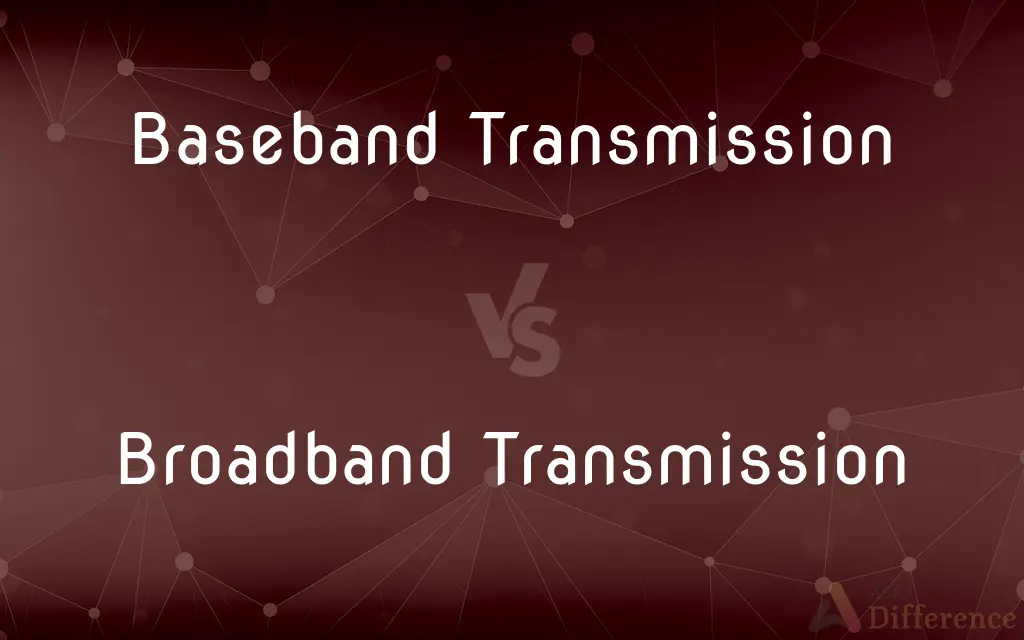Baseband Transmission vs. Broadband Transmission — What's the Difference?
By Tayyaba Rehman — Published on January 14, 2024
Baseband Transmission uses a single channel for one signal at a time, ideal for short distances. Broadband Transmission uses multiple channels, allowing simultaneous multiple signals, suitable for long distances.

Difference Between Baseband Transmission and Broadband Transmission
Table of Contents
ADVERTISEMENT
Key Differences
Baseband Transmission refers to transmitting a single data signal over a single channel. The entire bandwidth of the communication medium is used to transmit one signal at a time, typically over short distances. In contrast, Broadband Transmission uses multiple frequency channels to transmit several signals simultaneously. This is achieved through techniques like frequency division multiplexing.
Baseband Transmission is typically used in local area networks (LANs), where data is transmitted in a digital format over a single channel. Ethernet is a common example. Broadband Transmission, however, is often used in wide area networks (WANs) where analog signals are transmitted over multiple channels, as seen in cable television networks.
In terms of signal processing, Baseband Transmission does not require modulation of the digital signal. It is transmitted in its original form. On the other hand, Broadband Transmission often requires the analog signal to be modulated at different frequency bands for simultaneous transmission.
Baseband Transmission tends to be simpler and more cost-effective but is limited by its range and capacity to carry only one signal at a time. Broadband Transmission, while more complex and expensive, can cover larger distances and support multiple, high-capacity transmissions concurrently.
Baseband Transmission typically uses twisted pair cables for signal transmission, while Broadband Transmission often utilizes coaxial or fiber optic cables, which are better suited for carrying multiple high-frequency signals over long distances.
ADVERTISEMENT
Comparison Chart
Signal Type
Digital signal over a single channel
Multiple analog signals over multiple channels
Usage
Local Area Networks (LANs)
Wide Area Networks (WANs), cable TV
Modulation
Not required
Required for different frequency bands
Range and Capacity
Shorter range, single signal at a time
Longer range, multiple signals simultaneously
Common Transmission Medium
Twisted pair cables
Coaxial or fiber optic cables
Compare with Definitions
Baseband Transmission
Transmits a single signal over a single channel.
Our office LAN uses baseband transmission for internal networking.
Broadband Transmission
Uses multiple channels for simultaneous signals.
Our cable TV utilizes broadband transmission for multiple channels.
Baseband Transmission
Ideal for short-distance communication.
Baseband transmission is suitable for our building's network infrastructure.
Broadband Transmission
Transmits analog signals.
Broadband transmission in our WAN supports high-speed internet and TV.
Baseband Transmission
No signal modulation required.
Baseband signals are transmitted in their original digital format.
Broadband Transmission
Suitable for long distances.
Broadband transmission is used for our city-wide cable network.
Baseband Transmission
Uses the entire bandwidth of the medium.
Baseband transmission allows exclusive use of the cable's bandwidth.
Broadband Transmission
Often uses coaxial or fiber optic cables.
The internet provider installed fiber optic cables for broadband transmission.
Baseband Transmission
Common in digital local area networks.
Ethernet is a widely used form of baseband transmission.
Broadband Transmission
Requires signal modulation.
Modulating signals in broadband transmission allows for efficient data transfer.
Common Curiosities
What applications use Broadband Transmission?
Broadband is used in WANs, cable TV, and internet services.
What type of cables does Baseband Transmission use?
It primarily uses twisted pair cables.
What is Baseband Transmission?
It's the transmission of a single digital signal over a single channel.
Do Baseband signals require modulation?
No, they are transmitted in their original digital format.
Is Baseband Transmission suitable for long distances?
No, it's generally limited to shorter distances.
Can Baseband Transmission be used for internet?
Yes, but it's more common in local networks rather than wide-area internet connections.
Where is Baseband Transmission commonly used?
Typically in local area networks (LANs) like office or home networks.
What is Broadband Transmission?
It refers to transmitting multiple analog signals over multiple channels.
What type of modulation is used in Broadband Transmission?
Frequency division multiplexing is commonly used.
Can Broadband be used for wireless transmission?
Yes, it's widely used in both wired and wireless communication.
Can Broadband Transmission carry digital signals?
Yes, but they need to be modulated onto analog carrier waves.
How do Baseband and Broadband differ in terms of frequency usage?
Baseband uses the entire frequency spectrum of the medium, while Broadband divides it into multiple channels.
What is a major advantage of Broadband over Baseband?
Its ability to transmit multiple signals simultaneously over long distances.
Why is Broadband Transmission more expensive than Baseband?
Due to its complexity and the need for multiple channels and modulation.
Is Broadband Transmission faster than Baseband?
Broadband can handle higher capacities and is better for long distances, which can translate to higher overall speeds.
Share Your Discovery

Previous Comparison
Antibiotics vs. Vaccines
Next Comparison
AM Radio vs. FM RadioAuthor Spotlight
Written by
Tayyaba RehmanTayyaba Rehman is a distinguished writer, currently serving as a primary contributor to askdifference.com. As a researcher in semantics and etymology, Tayyaba's passion for the complexity of languages and their distinctions has found a perfect home on the platform. Tayyaba delves into the intricacies of language, distinguishing between commonly confused words and phrases, thereby providing clarity for readers worldwide.












































